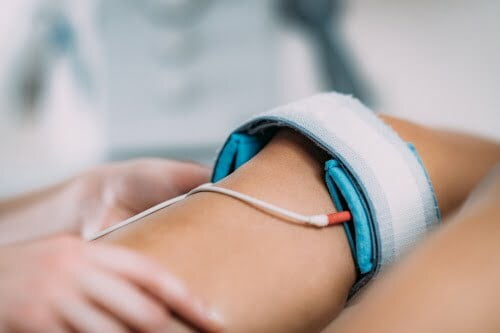
There are various Physiotherapy treatment options available to patients suffering from the pain of a physical injury. While Physiotherapists may use long-term solutions, such as exercise prescription and manual therapy, they might also implement electrotherapeutic modalities to assist with short-term swelling and pain reduction. Most electrotherapy modalities differ from one another, as there are several types and various techniques they can be used for.
How Do Electrotherapeutic Modalities Help?
Electrotherapeutic modalities use energy from electricity for light, magnetics, sonics, and heat. A Winnipeg Physiotherapist may use whichever options they feel are right for a treatment plan.
The different modalities may be used to assist with these Physiotherapy goals:
- Pain relief
- Inflammation reduction
- Improving circulation
- Promoting tissue healing and scar tissue remodelling
- Skin condition treatment
- Improving range of motion
- Enhancing muscle activation
- Preservation of strength
Electrotherapeutic modalities are often utilized in conjunction with other Physiotherapy techniques, which is why patients may not only want to rely on electrotherapy as a standalone treatment method.
A skilled Clinician will create a treatment plan specific to your needs, goals, and diagnosis. The machines at our clinic are designed to assist in pain reduction, decreasing inflammation and muscular weakness.

TENS (Transcutaneous Electrical Nerve Stimulation)
Transcutaneous electrical nerve stimulation (also known as TENS) aims to provide pain relief by exciting the body’s sensory nerves and stimulating the pain gate mechanism or opioid system. The method and effectiveness of TENS can vary depending on the patient’s Physiological mechanisms, as well as the type of pain treated.
Our transcutaneous electrical nerve stimulation machine features four electrodes which are placed on the affected areas experiencing pain or swelling. While the TENS unit incorporates the gate control theory, it distracts the nervous system from acknowledging the pain, resulting in pain reduction.
This treatment method often works for people dealing with chronic pain and has shown to be an ideal option for treating acute injury pain.
IFC (Interferential Current)
The interferential current ( commonly referred to as IFC) uses a low-frequency electrical stimulation of the nerves that relieves pain, increases blood flow in the area, and reduces the effects of swelling from oedema.
However, to produce the low-frequency effects, patients may experience discomfort in the superficial tissues, such as the skin. This is a result of skin impedance as the skin is becoming inversely proportional to the frequency of the stimulation experienced.
The interferential current machine operates under the same basic principles as the transcutaneous electrical nerve stimulation. It still helps to reduce pain and swelling, but the main difference is that the IFC machine allows for deeper tissue penetration.
NMES (Neuromuscular Electrical Stimulation)
The NMES method uses electrical impulses to contract specifically targeted muscles to strengthen them. The electrical impulses can cause the muscles to contract and offset the effects of disuse. Essentially, this method is used to “retrain” a muscle to properly function and build strength, especially after a surgical procedure.
The NMES is primarily utilized to stimulate muscles for the treatment of muscular and neural deficits, fatiguing muscle spasms, and to promote pain management.
Neuromuscular treatment is also useful for a variety of applications, including strength training and post-exercise recovery for athletes, as well as testing muscular and nerve functions. It’s also used for the rehabilitation of injured individuals.
Low-Level Intensity Laser Therapy
Laser is an acronym for Light Amplification by Stimulated Emission of Radiation. Low-level laser therapy is a method used in some Physiotherapy treatments to assist with musculoskeletal conditions. Low-level laser therapy is a non-invasive light source technique that generates a single wavelength of light. It emits no heat, sound, or vibration when being used.
Laser therapy during Physiotherapy rehabilitation applies low-level/power laser LEDs (light-emitting diodes) to affected areas of pain or impairment in the body. The laser provides stimulation and enhances cell function to improve healing and reduce pain.
In Physiotherapy, laser therapy can be used to treat specific conditions, such as:
- Rheumatoid arthritis
- Osteoarthritis
- Temporomandibular disorders
- Bursitis
- Tendonitis
- Tennis elbow
- Plantar fasciitis
- Sciatica
- Disc herniation
- Lower back disc degeneration
However, there are specific conditions in which laser therapy should not be used, such as:
- Cancer: Don’t treat over the site of any known primary carcinoma or secondary metastasis unless the patient is currently undergoing chemotherapy.
- Epilepsy: Low-frequency pulsed light may trigger a seizure if the patient is epileptic.
- Pregnancy: Laser therapy cannot be used to treat the area of a developing fetus.
Ultrasound
This is a well-known electrotherapy method that doesn’t use electricity in its application at all. Ultrasound therapy uses mechanical vibrations at increasing frequencies to produce focused ultrasonic energy to provide pain relief. The flow of the ultrasound may either be delivered as an uninterrupted stream (continuous mode) or with periodic interruptions (pulsed mode).
Ultrasound therapy is classified as a deep heating modality that has the capabilities of producing increased temperatures on soft tissue structures in the body. It can also be used to assist muscle, tendon, and ligament pain.
Some of the following benefits of ultrasound include:
- Increased circulation to the soft tissues
- Decreased pain
- Increased elasticity
- Helps the body heal
At our clinic, the ultrasound unit is used for deep heating tissues, as well as to penetrate sound waves into an affected area to assist with reducing swelling, promote healing, and break up scar tissue or adhesions.
Depending on the type of treatment you require, electrotherapeutic modalities offer a wide range of benefits that are used in conjunction with other treatment options. If you’re seeking assistance for an acute injury, book an appointment with our Winnipeg Physiotherapy clinic today. Our trained Physiotherapists are here to relieve the pain.



